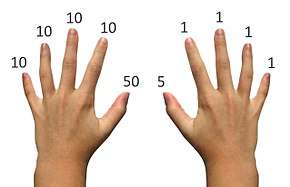Chisanbop

Chisanbop or chisenbop (from Korean chi (ji) finger + sanpŏp (sanbeop) calculation[1] 지산법/指算法) is an abacus-like finger counting method used to perform basic mathematical operations. According to The Complete Book of Chisanbop[2] by Hang Young Pai, chisanbop was created in the 1940s in Korea by Sung Jin Pai and revised by his son Hang Young Pai. He then brought the system to the United States c. 1977. With this method it is possible to display all numbers from 0 to 99 with two hands.
Basic concepts
The hands are held in a relaxed posture on or above a table. All fingers are floating off the table to begin with. The fingers are pressed into the table to indicate value. Each finger (but not the thumb) of the right hand has a value of one. Press the index finger of the right hand onto the table to indicate "one." Press the index and middle fingers for “two”, the three leftmost fingers for “three”, and all four fingers of the right hand to indicate “four”. The thumb of the right hand holds the value “five”. To place the value “six”, press the right thumb and index finger onto the table. The thumb indicates “five” plus the “one” indicated by the finger. The left hand represents the tens digit. It works like the right hand, but each value is multiplied by ten. Each finger on the left hand represents “ten”, and the left thumb represents “fifty”. In this way, all values between zero and ninety-nine can be indicated on two hands.
Notation
A proposed notation system for representing the numbers:
. = a finger off the table o = a finger on the table - = a thumb off the table @ = a thumb on the table
Values between zero and 9 are shown with the entire right hand:
@oooo = 9 @ooo. = 8 @oo.. = 7 @o... = 6 @.... = 5 -oooo = 4 -ooo. = 3 -oo.. = 2 -o... = 1 -.... = 0
.jpg)
Values larger than 10 are shown with both hands:
..oo- @.... = 25 oooo- -.... = 40 ....@ @.... = 55 oooo@ @.... = 95
Adoption in the United States
A school in Shawnee Mission, Kansas, ran a pilot program with students in 1979. It was found that although they could add large numbers quickly, they could not add them in their heads. The program was dropped. Grace Burton of the University of North Carolina said "It doesn't teach the basic number facts, only to count faster. Adding and subtracting quickly are only a small part of mathematics."[3]
See also
References
- ↑ chisanbop. (n.d.). Dictionary.com Unabridged (v 1.1). Retrieved June 29, 2007, from Dictionary.com website: http://dictionary.reference.com/browse/chisanbop
- ↑ Pai, Hang Young (1981). The Complete Book of Chisanbop: Original Finger Calculation Method Created by Sung Jin Pai and Hang Young Pai. Van Nostrand Reinhold. ISBN 0-442-27568-4.
- ↑ https://www.csmonitor.com/1982/0517/051703.html
Further reading
- Lieberthal, Edwin M. (1979). The Complete Book of Fingermath. New York: McGraw-Hill. ISBN 0-07-037680-8.